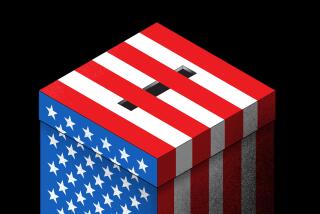Jobs Are the Wild Card in Swing States
Thirty states added jobs last month and 20 reported declines, the Labor Department said Friday. Some of the largest gains and losses occurred in battleground states that could determine the outcome of the presidential election.
Among August’s biggest gainers were the swing states of Florida, which created 16,600 payroll jobs, and Arizona, which added 10,200. The losers list included politically pivotal Ohio, which shed 11,800 jobs, and Missouri, which dropped 5,500.
The state-by-state job tallies underscored the spotty nature of the recovery and the problematic consequences for President Bush, whose economic stewardship is a central issue in the presidential campaign.
Although a majority of states -- and the nation as a whole -- have been adding jobs over the past year, employers are still paring payrolls in a handful of states considered winnable by either Bush or the Democratic challenger, Sen. John F. Kerry.
“There’s no better evidence of George Bush’s wrong choices than Ohio’s economy, which saw more job losses than any other state last month,” Kerry said in a statement. He noted that Ohio had lost 237,400 payroll jobs since Bush took office.
“Ohio needs some good news,” acknowledged Treasury Secretary John Snow in remarks at a worker retraining roundtable at Hondros College in Westerville, Ohio.
“You’ve had a net gain of nearly 12,000 new jobs since January, but it hasn’t been enough, and gains haven’t been as steady as we’d like.”
White House spokesman Scott McClellan, asked if Bush was concerned that Ohio was still losing jobs, said Friday’s employment figures “continue to show that the economy is moving forward, and because of the policies that this president has implemented.”
Economists and political analysts said it was unclear how much impact the new state employment figures would have at this stage of the presidential campaign, when the views of many voters appeared to have hardened and other issues appeared to be exerting more influence on their choices than the economy.
“Any little advantage they can get on these employment numbers is still important,” said Greg Valliere, chief strategist at the nonpartisan Charles Schwab Washington Research Group. “But I’m not sure that ordinary voters are that focused on these numbers. There are other issues, namely Iraq and terrorism, that seem to be more dominant right now.”
Still, analysts said the job figures could make a difference at the margin, particularly with undecided voters in Midwestern swing states that had been hit particularly hard by the manufacturing downturn of recent years.
“Job growth has been very uneven throughout the country this year,” said Charles McMillion, president of MBG Information Services, a data analysis firm in Washington.
“I’m sure the campaigns are going to play it very differently in each state. It just depends on how well they play it. But certainly this big loss in Ohio will be an issue in a very important state.”
John Green, director of the University of Akron’s Ray C. Bliss Institute of Applied Politics, said the job figures corroborated what many Ohioans already had concluded about the job market in their state.
“Believe me, this is not good news for the president, by any stretch of the imagination,” Green said. “But people pretty much know that the economy is bad. For a lot of them, this will just confirm that feeling.”
Green said it appeared that most Ohio residents had picked a presidential favorite and were unlikely to change their minds. “But these numbers may motivate more of the Democratic base to get out and vote,” he said. “It will be harder for the president to say things are getting better.”
August’s state-by-state gains and losses occurred during a month in which the U.S. job count increased by 144,000 and the national unemployment rate dipped to 5.4% from 5.5% in July.
Although the last recession officially ended in November 2001, employers continued to shed jobs for nearly two more years, making employment a major issue in the presidential race.
U.S. employers have added 1.7 million jobs over the past year, but the job count remains 913,000 below where it was when Bush took office.
Among the 17 politically pivotal swing states, 11 posted job increases in August and six recorded losses, Friday’s figures showed.
Florida and Arizona led the list of gainers, followed by Michigan with 7,200 new jobs, and Pennsylvania with 6,400. There were smaller increases in Minnesota, Maine, Iowa, Arkansas, Nevada, New Mexico and West Virginia.
The roster of job losers was dominated by Ohio and Missouri, followed by losses of 3,000 jobs in Washington, 1,100 in Wisconsin, 900 in Oregon and 500 in New Hampshire.
The unemployment rate declined in six of the swing states and increased in 11, the Labor Department reported. The jobless rate and job count can increase at the same time if large numbers of young workers enter the labor force or large numbers of job-market dropouts begin looking for work again.
Among the battleground states, New Hampshire recorded the lowest jobless rate, 3.7%, followed by Nevada at 4%. Oregon posted the highest rate, 7.4%, with Michigan second at 6.7%.
Chief economist Mark Zandi at Economy.com, a data analysis firm in West Chester, Pa., said the figures reflected trends that had been at work for some time: steady job creation in parts of the South and West, and continuing losses in some Midwestern states.
For that reason, Zandi said, the new figures were unlikely to change political sentiment in states such as Florida or Ohio.
*
(BEGIN TEXT OF INFOBOX)
Job swings
Two of the biggest job losers this summer were the presidential election battlegrounds of Ohio and Missouri, according to a Labor Department report. Job gains and losses in presidential swing states:
Job gains and losses in swing states (change from July to August):
*--* Arizona 10,200 Arkansas 2,900 Florida 16,600 Iowa 3,400 Maine 3,500 Michigan 7,200 Minnesota 3,500 Missouri -5,500 Nevada 2,800 New Hampshire -500 New Mexico 2,300 Ohio -11,800 Oregon -900 Pennsylvania 6,400 Washington -3,000 West Virginia 1,100 Wisconsin -1,100
*--*
Source: Bureau of Labor Statistics
More to Read
Get the L.A. Times Politics newsletter
Deeply reported insights into legislation, politics and policy from Sacramento, Washington and beyond. In your inbox three times per week.
You may occasionally receive promotional content from the Los Angeles Times.






